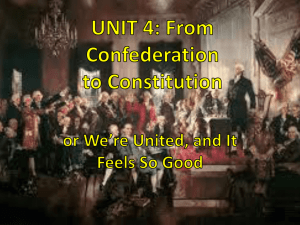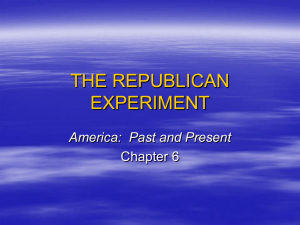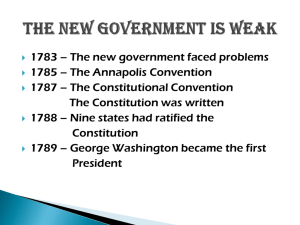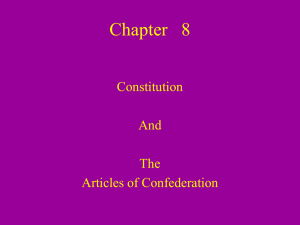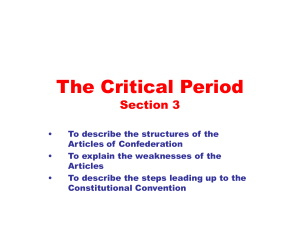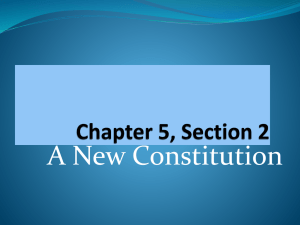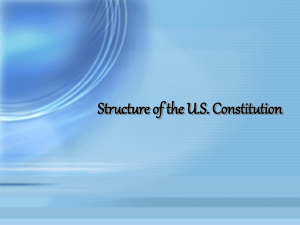Ch 9 The Confederation & The Constitution
advertisement
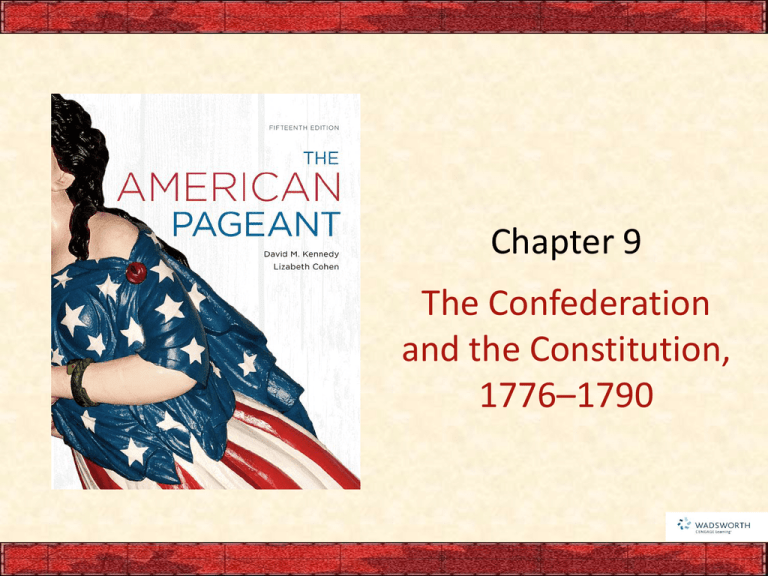
Chapter 9 The Confederation and the Constitution, 1776–1790 p156 p157 I. The Pursuit of Equality • Equality was the watchword everywhere: – Most states reduced property-holding requirements for voting – Ordinary men and women demanded to be addressed as “Mr.” and “Mrs.” – Employers were now called “boss,” not “master” – The lordly pretentions of Continental Army officials who formed the Society of the Cincinnati were ridiculed. I. Pursuit of Equality (cont.) • A protracted fight for separation of church and state resulted in notable gains: – The Congregational Church continued to be legal established – The Anglican Church was de-anglicized, and reformed as the Protestant Episcopal Church – The struggle for divorce between religion and government proved fiercest in Virginia. I. Pursuit of Equality (cont.) • It was prolonged to 1786, when freethinking Thomas Jefferson and his co-reformers, include the Baptists, won a complete victory with the passage of the Virginia Statute for Religious Freedom (see Table 5.1). • Egalitarian sentiments challenged the institution of slavery: – Philadelphia Quakers in 1775 founded the first’s antislavery society I. Pursuit of Equality (cont.) – Hostilities hampered the noxious trade in “black ivory” – The Continental Congress, 1774 called for the complete abolition of the slave trade, a summons to which most states responded positively. – Several Northern states called for either abolishing slavery outright or providing for the gradual emancipation of blacks – Even on the plantations of Virginia, a few idealistic masters freed their human chattels – No state south of Pennsylvania abolished slavery – In both the North and South the law discriminated against freed blacks and slaves alike I. Pursuit of Equality (cont.) • Why not more rapid changes: – The fledgling idealism of the Founding Fathers was sacrificed to political expediency – A fight over slavery would fracture the fragile national unity that was needed • “Great as the evil (of slavery) is, a dismemberment of the union would be worse” James Madison, 1787 – Nearly a century later, the slavery issue did wreck the Union—temporarily. I. The Pursuit of Liberty (cont.) • Incomplete was the extension of the doctrine of equality to women: – Some women did serve in the military – New Jersey’s new constitution (1776) enabled women to vote – Most women in the Revolutionary era were still doing traditional women’s work. I. The Pursuit of Equality (cont.) • Central to republican ideology was: – Civic virtue—the notion that democracy depended on the unselfish commitment of each citizen to the public good • And who could better cultivate the habits of a virtuous citizenry than mothers, to whom society entrusted the moral education of the young? • The idea of “republican motherhood” elevated women to a newly prestigious role as special keepers of the nation’s conscience. I. The Pursuit of Equality (cont.) – Educational opportunities for women expanded, in the expectation that wives and mothers could better cultivate the virtues demanded by the Republic – Republican women now bore responsibility for the survival of the nation. II. Constitution Making in the States • The Constitutional Congress, 1776, called for the colonies to draft a new constitution: – Asking the colonists to summon themselves into being as new states – The sovereignty of the new states would rest on the authority of the people – The states of Connecticut and Rhode Island merely retouched their constitutions – Other colonies would write new constitutions. II. Constitution Making in the States (cont.) • Massachusetts called for a special convention to draft its constitution and then submitted the final draft to the people for ratification – Once adopted the constitution could only be changed by another constitutional convention – Its constitution remained the longest-lived constitution in the world. II. Constitution Making in the States (cont.) • Common constitutional features: – As written documents the state constitutions were intended to represent a fundamental law, superior to the whims of ordinary legislation – Most contained bills of rights—long-prized liberties against later legislative encroachment. – Most required the annual election of legislators – All deliberately created weak executive and judicial branches. II. Constitution Making in the States (cont.) • In the new government, the legislatures were given sweeping powers: – The democratic character was reflected by the presence of many members of the recently enfranchised poorer western districts – Their influence was felt in the moving of many state capitals – In many states capitals were moved westward. III. Economic Crosscurrents • Economic changes: – States seized control of former crown lands – Land was cheap and easily available – In America economic democracy preceded political democracy – A sharp stimulus was given to manufacturing. III. Economic Crosscurrents (cont.) • Economic independence had drawbacks: – Much of British commerce was reserved for the loyal parts of the empire – American ships were now barred from British and British West Indies harbors – Fisheries were disrupted – New commercial outlets compensated partially for the loss of old ones. III. Economic Crosscurrents (cont.) – Americans could now trade freely with foreign nations • War had spawned demoralizing extravagance, speculation, and profiteering • State governments had borrowed more during the war then they could ever hope to repay • Runaway inflation had been ruinous to many citizens. • The average citizen was worse off financially at the end of the shooting than at the start. III. Economic Crosscurrents (cont.) • The whole economic and social atmosphere was unhealthy: – A newly rich class of profiteers was conspicuous – Once-wealthy people were destitute – The controversy leading to the Revolutionary War had bred a keen distaste for taxes and encouraged disrespect for the majesty of the law generally. p161 p162 IV. A Shaky Start Toward Union • The Revolution placed the responsibility of creating and operating the new government squarely on the people – What were they to do about “natural rights?” – Disruptive forces stalked the land – Departed Tories left the political system inclined toward experimentation and innovation • Yet the 13 sovereign states, basically similar, enjoyed a rich political inheritance and were blessed with good political leaders. V. Creating a Confederation • The Second Continental Congress: – Little more than a conference of ambassadors – It was totally without constitutional authority – It did only what it dared to do – It asserted some control over the military and foreign power. • In all respects, the 13 states were sovereign: • They coined money, raised armies and navies, erected tariff barriers. V. Creating a Confederation (cont.) • The Articles of Confederation: – Adopted by Congress in 1777, but were not ratified by the states until 1781 – Chief point of contention was the western lands • 6 states had no holdings beyond the Allegheny Mountains • 7, notably New York and Virginia, were favored with enormous acreage • The land-rich states could use the trans-Allegheny tracts and pay off pensions and other debts. V. Creating a Confederation (cont.) – Unanimous approval of the Articles by the 13 states was required: • Starved Maryland held out until March 1, 1781, on agreement of New York to surrender its western land • Congress pledged itself to dispose of these vast areas for the “common benefit.” • It also promised to carve a number of “republican” states, which with time would be admitted to the union • The pledge was fully redeemed in the Northwest Ordinance of 1787 (see Map 9.1). Map 9-1 p163 VI. The Articles of Confederation: America’s First Constitution • The Articles of Confederation: – Had some “Articles of Confusion”—provided for a loose confederation or “firm league of friendship” • 13 independent states were linked together to deal with common problems, such as foreign affairs • A clumsy Congress was to be the chief agency • There was no executive branch • The judicial was left almost exclusively to the states. VI. The Articles of Confederation: America’s First Constitution (cont.) • Congress, though dominant, was severely hobbled: – Each state had a single vote – All bills dealing with subjects of importance required the support of nine states – Any amendment of the Articles themselves required unanimous ratification. – Congress was weak—and was purposely designed to be weak. VI. The Articles of Confederation: America’s First Constitution (cont.) • Two major weakness of The Articles: – Congress had no power to regulate commerce – Congress could not enforce its tax-collection programs. • The new government could advise, advocate and appeal: – In dealing with independent states, it could not coerce or control. – Nor act directly towards individual citizens. VI. The Articles of Confederation: America’s First Constitution (cont.) • The new Congress, with paper power, was less effective than the Continental Congress. – Yet, the Articles proved to be a landmark – They were a model of a loose confederation – The states would need to yield their sovereignty to a new recast government, that would leave them free to control their local affairs. – The anemic Articles were a significant stepping stone toward a new constitution. VI. The Articles of Confederation: America’s First Constitution (cont.) • The Articles: – Were the first written constitution of the Republic – Kept alive the ideal of union and held the states together – Great leap from the old boycott Association of 1774 and the Constitution of the United States. p164 Map 9-2 p165 VII. Landmarks in Land Laws • Passages of public domain legislation: – Old Northwest area northwest of the Ohio River, east of the Mississippi River, of the Great Lakes – Land Ordinance of 1785 (see Map 9.2) provided for the acreage of the Old Northwest to be sold and the proceeds to pay the national debt • Surveyed, then divided into townships, and finally into sections • Sixteen sections for education. VII. Landmarks in Land Laws (cont.) • Northwest Ordinance of 1787: – This ordinance related to the governance of the old Northwest: how a nation should deal with its colonies • First temporary tutelage, then permanent equality • First, two evolutionary territorial stages under the subordination of the federal government • When a territory had 60,000 inhabitants, it might be admitted by Congress as a state • The Ordinance forbid slavery. VIII. The World’s Ugly Duckling • Foreign relations with Britain: – Remained troubling • Refused to send a minister to America • Declined to make a commercial treaty or to repeal its ancient Navigation Laws • Closed the profitable West Indies trade to the states • Sought, with the help of the Allen brothers of Vermont, to annex that rebellious area to Britain • The redcoats maintained a chain of trading posts • Maintained fur trading with the Indians. VIII. The World’s Ugly Duckling: (cont.) • Spain was openly hostile to the new Republic • She controlled the all-important Mississippi River, forcing the pioneers to float their produce • In 1784 Spain closed the river to American commerce threatening the West with strangulation • She claimed a large area north of the Gulf of Mexico • Schemed with the Indians to hem in the Americans east of the Appalachians. • Spain and Britain influenced the Indians, preventing America from exercising effective control over half of its territory (see Map 9.3). VIII. The World’s Ugly Duckling (cont.) • France, America’s friend, cooled off now that it had humbled Britain • Pirates of North Africa ravaged America’s Mediterranean commence • Britain purchased protection for their own subjects, but not for independent Americans. Map 9-3 p167 IX. The Horrid Specter of Anarchy • Economic clouds of mid-1780s: – Requisition of raising money was broken down – Interest on the public debt was piling up – Individual states were getting out of hand – Some states were levying their own duties – Some were printing depreciated paper money. IX. The Horrid Specter of Anarchy (cont.) • Shays’ Rebellion in western Massachusetts: • Improvised farmers were losing their farms through mortgage foreclosures and tax delinquencies • Led by Captain Daniel Shays, these desperate debtors demanded: – That the state issue paper money, lighten taxes, and suspend property takeovers • Hundreds of angry agitators attempted to enforce these demands. • Massachusetts authorities responded with drastic action by raising a small army skirmishes occurred, 3 Shaysites were killed 1 wounded—the movement collapsed. IX. The Horrid Specter of Anarchy (cont.) • Shays’ followers were crushed, but the nightmarish memory continued: • The Massachusetts legislature passed debtor-relief laws • Shays’ outburst caused fear for the propertied class • Civic virtue was no longer to rein in self-interest and greed IX. The Horrid Specter of Anarchy (cont.) • How critical were conditions under the Confederation? • Conservatives, protecting their wealth, exaggerated the seriousness of the nation’s plight • They thought to amend the Articles of Confederation in favor of a muscular central government • Some feared that a powerful federal government would force them to pay their creditors • Both friends and critics of the Confederation agreed that it needed to be strengthened. p168 X. A Convention of “Demigods” • Annapolis convention of 1786: – Nine states appointed delegates, only 5 attended – Alexander Hamilton saved the convention: • He called for a convention in Philadelphia 1787 • To deal with commerce and to bolster the entire fabric of the Articles of Confederation – Eventually Congress called for a convention “for the sole and express purpose of revising” the Articles. • Each state chose representatives, except for independent-minded Rhode Island. X. A Convention of “Demigods” (cont.) • A quorum of 55 emissaries from 12 states convened in Philadelphia on May 25, 1787 • Sessions were held in secrecy, with armed sentinels posted at the doors. • The caliber of the participants was extraordinarily high—“demigods,” Jefferson called them • Most were lawyers with experience at constitutionmaking in their own states • George Washington was elected chairman • Benjamin Franklin added the urbanity of an elder statesman. X. A Convention of “Demigods” (cont.) • James Madison’s contributions were so notable he was dubbed “the Father of the Constitution” • Alexander Hamilton was an advocate for superpowerful central government • Most Revolutionary leaders of 1776 were absent • Jefferson, J. Adams and Thomas Paine in Europe • Samuel Adams, John Hancock were not elected • Patrick Henry was elected from Virginia, but declined, declaring he “smelled a rat.” – The time had come to fashion a solid political system. XI. Patriots in Philadelphia • The 55 delegates: • Were a conservative, well-to-do body of lawyers, merchants, shippers, land speculators, moneylenders • Not a single person spoke for the debtor groups • Young (average age 42) but experienced statesmen • Nationalists, interested in preserving the young Republic then stirring popular democracy • Hoped to crystallized the last evaporating pools of Revolutionary idealism into a stable political structure that would endure. XI. Patriots in Philadelphia (cont.) • Strongly desired a firm, dignified, and respected government • Believed in republicanism but sought to protect the American experiment from weakness abroad and excesses at home • Wanted the central government to control tariffs in order to secure commercial treaties from foreign nations • Were determined to preserve the union, forestall anarchy, and ensure security of life and property against dangerous uprisings by the “mobocracy.” XI. Patriots in Philadelphia (cont.) • Above all—they sought to curb the unrestrained democracy rampant in several states • Grinding necessity extorted the Constitution from a reluctant nation • Fear occupied the fifty-sixth chair. XII. Hammering Out a Bundle of Compromises • Some delegates decided to completely scrap the old Articles of Confederation – Despite explicit instructions from Congress to revise – They were determined to overthrow the existing government by peaceful means (see Table 9.1). XII. Hammering Out a Bundle of Compromises (cont.) • Proposals: • Virginia Plan—“the large-state plan”: representation in both houses of a bicameral Congress should be based on population—an arrangement that was to the larger states’ advantage • New Jersey Plan—“the small-state plan”: provided for equal representation in a unicameral Congress, regardless of size and population – The weaker states feared that the Virginia scheme would lord it over the rest. XII. Hammering Out a Bundle of Compromises (cont.) • The Great Compromise: • The larger states were conceded representation by population in the House of Representatives (Art. I, Sec. II, para. 3 see the Appendix) • The smaller states wee appeased by equal representation in the Senate (Art. I, Sec. III, para. 1) • Agreed that all tax bills or revenue measures must originate in the House, where population counted more heavily (Art. I, Sec. VII, para. 1). • The critical compromise broke the logjam. XII. Hammering Out a Bundle of Compromises (cont.) • The final Constitution was: • Short because it grew out of Anglo-American common law legal tradition which made it unnecessary to be specific • It mostly provided a flexible guide to broad rules of procedures rather than detailed laws • The original (unamended) Constitution contained just 7 articles and ran about 10 pages to print. XII. Hammering Out a Bundle of Compromises (cont.) • The President: • Was to have broad authority to make appointments to domestic officers—including judgeships • Was to have veto power of legislation • Was not to have absolute power to wage war— Congress retained the crucial right to declare war • The Constitution as drafted was a bundle of compromises – Method of electing the president indirectly by the Electoral College rather than direct means XII. Hammering Out a Bundle Compromises (cont.) – State’s share of electors was based on the total of its senators and representatives in Congress (see Art. II, Sec. I, para. 2) – How should slaves be counted: • The compromise was a slave might count as threefifths of a person—three-fifths compromise (see Art. I, Sec. II, para. 3): • Slave trade might continue until the end of 1807 (see Art. I, Sec. IX, para 1). Table 9-1 p170 p171 XIII. Safeguards for Conservatism • Agreement among delegates was large: – Economically they generally saw eye to eye: • They demanded sound money and the protection of private property – Politically they were in basic agreement: • They favored a strong government, with three branches and with checks and balances XIII. Safeguards for Conservatism (cont.) – Other safeguards: • The federal judges were to be appointed for life • The powerful president was to be elected indirectly by the Electoral College • The senators were to be chosen indirectly by state legislatures (see Art. I, Sec. III, para. 1) • The House of Representatives—were qualified (propertied) citizens permitted to choose their officials by direct vote (see Art. 1, Sec. II, para. 1). XIII. Safeguards for Conservatism (cont.) • Democratic elements in the new charter: – Stood on two great principles of republicanism • That the only legitimate government was one based on the consent of the governed • That the powers of government should be limited—in this case to a written constitution • The virtue of the people, not the authority of the state, was to be the ultimate guarantor of liberty, justice, and order. – After 17 weeks—May 25 to September 17, 1787—only 42 of the original 55 remained to sign the Constitution. XIV. The Clash of Federalists and Antifederalists • The Framing Fathers early foresaw that nationwide acceptance of the Constitution would not be easy to obtain: • Unanimous ratification by all 13 states according to the still-standing Articles of Confederation • Since Rhode Island was certain to veto, the delegates stipulated when 9 states had approved through specifically elected conventions, the Constitution would be the supreme law of the land in those states ratifying (see Art. VII). XIV. The Clash of Federalists and Antifederalists (cont.) • The American people were now handed a new document (see Table 9.2): – The antifederalists—those who opposed the stronger federal government – The federalists—those supported a strong federal government. • Antifederalists—Samuel Adams, Patrick Henry, Richard Henry Lee were states’ rights devotees (see Map 9.4), also backcountry dwellers, one-horse farmers, paper-moneyites and debtors. XIV. The Clash of Federalists and Antifederalists (cont.) – Federalists were George Washington, Benjamin Franklin, those who lived on the seaboard, wealthy, educated, better organized. – The antifederalists voiced vehement objections to the “gilded trap” known as the Constitution. Table 9-2 p173 Map 9-4 p174 XV. The Great Debate in the States • Special elections were held for members of the ratifying conventions (see Table 9.3) – The candidates—federalist or antifederalist— were elected based on whether they were for or against the Constitution • Four small states quickly accepted the Constitution • Pennsylvania was number two to ratify • Massachusetts prevented challenges, one of many was the demand for a bill of rights. XV. The Great Debate in the States (cont.) – Massachusetts ratified by a margin of 187 to 168 – Three more states signed – New Hampshire was the last. – All, but Virginia, New York, North Carolina, and Rhode Island had taken shelter under the “new federal roof” – The document was officially signed on June 21, 1788. Table 9-3 p175 XVI. The Four Laggard States • Virginia: • Provided fierce antifederalist opposition • They saw in the fearsome document the death warrant of liberty • G. Washington, J. Madison, and John Marshall, federalists lent influential support • New Hampshire: • After exciting debate in the state convention, ratified it 89 to 79. XVI. The Four Laggard States (cont.) • New York: • Alexander Hamilton finally supported the federalism as framed • He joined John Jay and James Madison in a series of articles for the New York newspapers • Called The Federalist Papers, were the most penetrating commentary ever written on the Constitution. • The most famous one is Madison’s Federalist No. 10. • It brilliantly refuted that it was impossible to extend a republican form of government over a large territory. XVI. The Four Laggard States (cont.) – New York finally yielded, ratifying by the close count of 30 to 27 – North Carolina, after a hostile convention, adjourned without taking a vote – Rhode Island didn’t summon a ratifying convention, rejected the Constitution by popular referendum – The two most ruggedly individualist centers remained true to form. XVI. The Four Laggard States (cont.) • No lives were lost, but riotous disturbances broke out in New York and Pennsylvania. • There was much behind-the-scenes pressure on delegates who had promised their constituents to vote against the Constitution. • The last four states ratified, not because they wanted to but because they had to • They could not safely exist outside the fold. p176 XVII. A Conservative Triumph • The minority had triumphed—twice: – A militant radical minority engineered the military Revolution that cast off the British constitution – A militant minority of conservatives had engineered the peaceful revolution that overthrew the inadequate Articles of Confederation. – A majority had not spoken. XVII. A Conservative Triumph (cont.) • Only ¼ adult white males had voted for delegates to the ratifying conventions • Conservatism was victorious • The principles of republican government were conserved through a redefinition of popular sovereignty • There was a self-limiting system of checks and balances among the branches and the Constitution reconciled the conflicting principles of liberty and order. • A marvelous achievement. p176 p179
